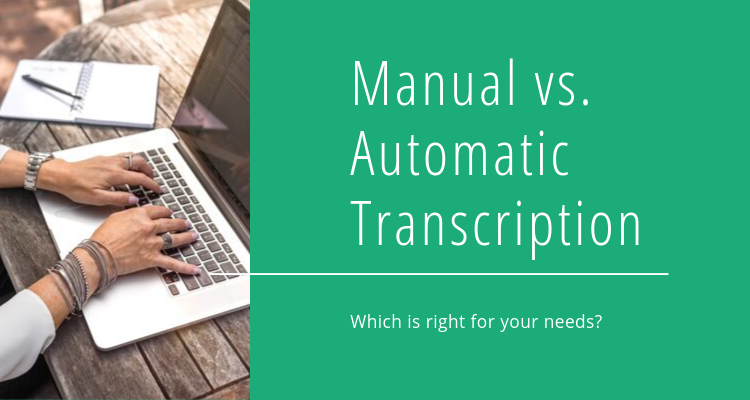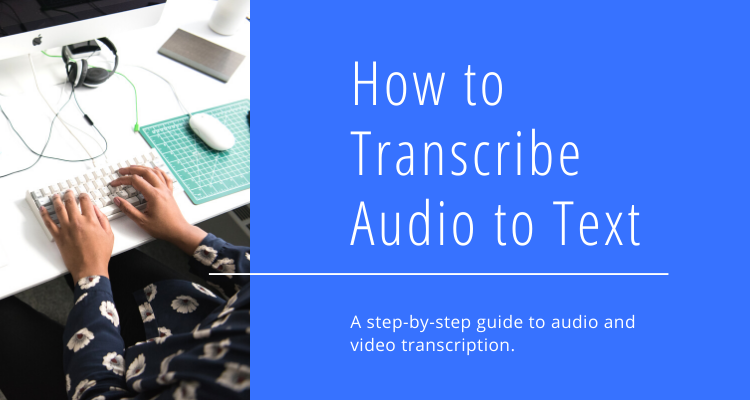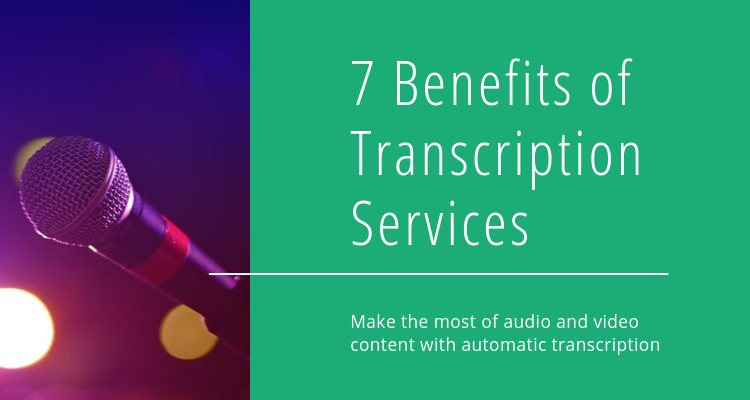
Audio and video to text solutions have exploded in recent years. Not only have they become more prevalent, but they’ve also become more accurate. For industries that require transcription services, like medical and legal fields, these advancements offer a potential opportunity for time and cost savings. For those who previously may not have been able to justify the investment in transcription services, like business and marketing, churches, and journalism, these advancements could present an opportunity to improve efficiency and accessibility that never existed before.
Regardless of the camp you’re in, you may be asking the question, is manual transcription or automatic transcription the best fit for my needs? To help you better understand your options, we’ve put together this article outlining the benefits of automated transcription, the benefits of manual transcription, and when to consider each of these options. Here’s what this article covers:
- About automatic transcription
- About manual transcription
- Key differences between manual and automatic transcription
- Comparing automatic transcription vs. manual transcription
About automatic transcription
With automatic transcription services, you typically upload the audio or video file you want transcribed via a web application interface. Some services also have a mobile app that will capture audio or video to transcribe in real time. Once the file is on the server, the automatic transcription service with transcribe the speech to text. The service will then notify you, usually in just a few minutes (depending on the length of the file), that your transcript is ready for you to review. Because automatic transcription is performed by machines, there are no humans involved in the actual transcription process. But without that educated eye doing the initial work, automatically generated transcripts typically require someone to proof the transcript to make sure the machine captured all of the data properly, especially things like unusual names and places or technical terms.
About manual transcription
Manual transcription services are performed by human transcriptionists. You typically create an account with the transcription company which will give you access to their system where you can upload the audio or video file you want transcribed. That file will then get assigned to a transcriptionist who will fit it into their queue within a couple of days. Once the transcriptionist is complete with her work, you’ll receive a notification that your transcript is ready for you. Your transcript should be exact, free of any typos, and if there are questions the transcriptionist has, they should indicate those for your review.
Key differences between manual and automatic transcription
Now that we have a baseline understanding of how manual vs. automatic transcription works, let’s discuss some of the differences in a bit more detail.
Transcription turnaround time
The first consideration when comparing manual transcription vs. automatic transcription is the length of time it takes to receive your transcript. For manual transcription, the industry standard is about four minutes of transcription time for every one minute of clear audio. That means it would take four hours on average of transcription time for just one hour of clear audio.
The transcription time itself isn’t the only factor, though. Because manual transcription requires a person to be actively doing the work, you won’t get your transcript back four hours after you submit your hour-long file. 48 to 72 hours is a pretty standard turnaround time for manual subscription.
Automatic transcription, on the other hand, doesn’t require a person to do the heavy lifting of converting the audio to text. This allows for a much faster turnaround time. Services like Sound Transcription can transcribe a 60 minute audio or video file in as little as 5 minutes.
The substantial difference in turnaround time for your transcriptions makes automatic transcriptions the clear favorite in this category, but there are also other factors to consider.
Cost of transcription
In addition to the time it takes to transcribe your audio or video files, the cost of the process is another consideration. Using the industry standard mentioned above, even at just minimum wage, you’d be looking at around $30 to transcribe a single hour of audio or video. But manual transcription is a skilled trade, and transcriptionist charge as such. Typical manual transcription services can range from $1-2 per minute or $60-120 per hour-long audio or video file.
Automatic transcription services have significantly less overhead than manual transcription services, and that savings is often passed down to customers. For pay-as-you-go transcription softwares, $0.10-0.15 per minute is pretty standard, with even further discounts for users who subscribe to monthly or yearly services. This equates to a rate of $6 per hour, a 90% discount from its manually transcribed counterpart.
While both speed and cost heavily favor automatic transcription, there are still other factors that could make it worth the wait and the extra cost to go the manual route.
Subject matter expertise
Something that manual transcription can offer that automatic transcription may struggle with is understanding the context around your recording. For example, certain brand standards or industry jargon may be better understood and transcribed by a human. If well-polished copy that can be presented to an audience is essential for your needs, you may want to consider manual transcription. Due to their nature, legal documents are another example that would be better suited for manual transcription. However, if a bit rougher version will get the job done, automatic transcription can certainly save time and money.
Deciphering interference
When comparing humans to machines in the context of transcription, the quality of the audio matters. If your audio or video file has a lot of background noise, it may be difficult for an automated transcription service to pick up the words in the same way a human transcriptionist can. The same thing goes with thick accents or multiple speakers. However, if your audio is clear, speakers are close to the mic, background noise is limited, and accents are clear, the human touch may not make much of a difference. These are all factors to consider when making the decision between manual and automated transcription.
Accuracy of transcriptions
Another factor to consider is how accurate you need your transcriptions to be. While most automated transcription services today are upwards of 90% accurate, depending on audio quality, they still don’t quite rival the accuracy of human transcriptionists. If 100% accuracy isn’t vital for your transcription needs, you may be able to save a pretty penny by going the automated transcription route. But if you require highly accurate transcripts, it’s likely worth the extra expense.
Security
A final consideration when comparing manual vs. automatic transcription is the sensitivity of your audio or video files and your security requirements. When you take the human transcriptionist out of the equation, there is one less person exposed to the content, so if security is of concern, this can be a benefit. But there are also considerations with automated transcriptions. Medical documents, for example, are required to comply with HIPAA, so if you go the automated transcription route for medical documents, you’ll need to ensure the platform and server are compliant.
Comparing automatic transcription vs. manual transcription
Now that we have a clearer picture of the factors to consider when comparing automatic transcription vs. manual transcription, we can narrow down the key differences and when which makes sense.
| Factors to Consider | Manual Transcription | Automatic Transcription |
| Transcription turnaround time | 1-3 days | 1-30 minutes |
| Transcription cost | $1-2 per minute | $0.10-0.15 per minute |
| Subject matter expertise | When subject matter requires in-depth knowledge and vocabulary that isn’t found in the dictionary | When subject matter and vocabulary are fairly common dictionary terms |
| Audio quality | My audio has a lot of background noise or thick accents | My audio is clear and without background interference |
| Transcription accuracy | I need 99-100% accuracy | 90-95% accuracy is just fine |
| Data security | If audio involves highly sensitive information that cannot get into the wrong hands, carefully consider the options. This is more a matter of the provider chosen rather than manual vs. automatic transcription. | |




0 Comments